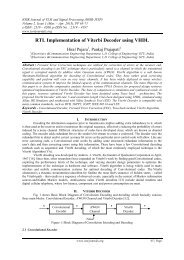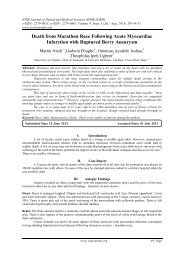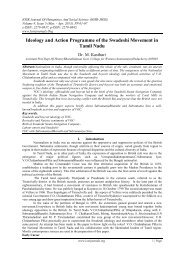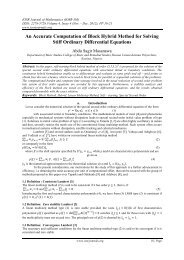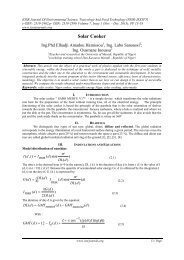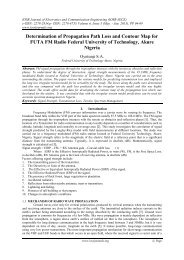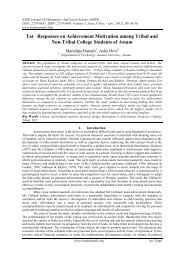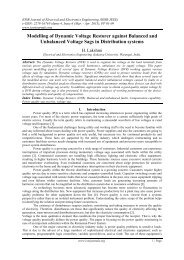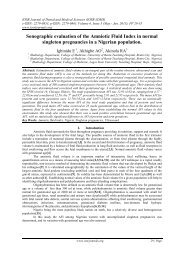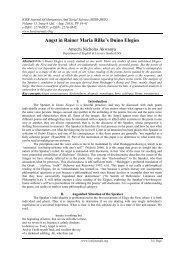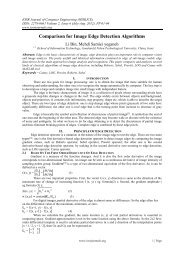Design Compatibility of Classroom Furniture in Urban and ... - IOSR
Design Compatibility of Classroom Furniture in Urban and ... - IOSR
Design Compatibility of Classroom Furniture in Urban and ... - IOSR
Create successful ePaper yourself
Turn your PDF publications into a flip-book with our unique Google optimized e-Paper software.
<strong>IOSR</strong> Journal Of Humanities And Social Science (JHSS)<br />
ISSN: 2279-0837, ISBN: 2279-0845. Volume 6, Issue 2 (Nov. - Dec. 2012), PP 41-45<br />
www.Iosrjournals.Org<br />
Àbèsàbèsì Orthography: A Proposal<br />
Taiwo Opeyemi Agoyi<br />
Department <strong>of</strong> L<strong>in</strong>guistics <strong>and</strong> Languages Adekunle Ajas<strong>in</strong> University Akungba- Akoko Ondo State, Nigeria<br />
Abstract: This paper proposes orthography for Àbèsàbèsì a language known as Akpes <strong>in</strong> Literature with<br />
ethnographic identity ibe. Agoyi 2008 proposed the name Àbèsàbèsì formed from the root morpheme Àbèsì ‘we’<br />
because it is the only identity accepted by all the n<strong>in</strong>e communities that speak variant <strong>of</strong> the language. All<br />
speakers <strong>of</strong> the language are aware <strong>of</strong> the endangered status <strong>of</strong> the language hence the need to have a writ<strong>in</strong>g<br />
system that will be used <strong>in</strong> writ<strong>in</strong>g literature <strong>in</strong> the language for teach<strong>in</strong>g <strong>and</strong> document<strong>in</strong>g the language. In l<strong>in</strong>e<br />
with Nigeria National Policy on Education 2004section 4 subsection 19e states that the medium <strong>of</strong> <strong>in</strong>struction<br />
<strong>in</strong> the primary school shall be the language <strong>of</strong> the environment for the first three years. Dur<strong>in</strong>g this period,<br />
English shall be thought as a subject. To be able to implement this policy there is the need to propose<br />
orthography for the languages to assist speakers <strong>of</strong> m<strong>in</strong>ority languages who feel the need to safe their languages<br />
from death. S<strong>in</strong>ce the speakers are familiar with the Yoruba orthography, this paper proposes graphemes that<br />
are close to the Yoruba graphemes. The orthography is based mostly on a co-language orthography pr<strong>in</strong>ciple.<br />
The proposed graphemes ware tested with literate speakers <strong>of</strong> the language. In all 37 graphemes are proposed<br />
for the consonants, vowels <strong>and</strong> tone phonemes the various dialects attest.<br />
This research is sponsored by Àbèsàbèsì Language Development committee.<br />
Key Words: Àbèsàbèsì multi-dialectal orthography, consonants, vowels, Nasalized vowels, tone, word,<br />
I. Introduction<br />
Thames <strong>and</strong> Hudson (2007:8) say that….a person who can read <strong>and</strong> write has greater opportunities for<br />
fulfillment than one who is illiterate’. Orthography represents wisdom <strong>and</strong> thought. It puts agreements law,<br />
comm<strong>and</strong>ments etc on record. It facilitates the growth <strong>of</strong> a state <strong>and</strong> people. There is power <strong>in</strong> the coded word.<br />
‘The comm<strong>and</strong>ment <strong>of</strong> a priest or k<strong>in</strong>g <strong>and</strong> his seal could go far beyond his sight <strong>and</strong> voice <strong>and</strong> could survive his<br />
death. The urgent for immortality has always been the first importance to writers’ writ<strong>in</strong>g can predict the future.<br />
Orthography serves the useful purpose <strong>of</strong> preserv<strong>in</strong>g the language. An endangered language that is reduced to<br />
writ<strong>in</strong>g for the few <strong>in</strong>terested speakers helps <strong>in</strong> rek<strong>in</strong>dl<strong>in</strong>g speakers’ <strong>in</strong>terest <strong>in</strong> the language. A good<br />
orthography helps to preserve the proto- language.<br />
We share Gary Simons (2011)’s view that ‘language variation limits communication’ He expla<strong>in</strong>s that<br />
dialectal variation may be so great as to prevent speakers <strong>of</strong> two dialects <strong>of</strong> the same language from<br />
underst<strong>and</strong><strong>in</strong>g one another. To him many <strong>of</strong> the limits to communication can be overcome <strong>in</strong> written<br />
communication. A unified orthography encourages different pronunciations <strong>of</strong> the same word. Each reader<br />
assigns his own pronunciation to the written symbols. In propos<strong>in</strong>g an orthography for Àbèsàbèsì, we take <strong>in</strong>to<br />
cognizance Simons’ pr<strong>in</strong>ciples <strong>of</strong> Multidialectal orthography which is always designed to be used by many<br />
dialects.<br />
Àbèsàbèsì ( known as Akpes <strong>in</strong> Literature <strong>and</strong> identified as ibe <strong>in</strong> Ethnography) is spoken <strong>in</strong> n<strong>in</strong>e<br />
communities <strong>in</strong> Akoko division <strong>of</strong> Ondo State Nigeria. The communities are Ìyànì, Ìbaràmù, Gèdègédé, (these<br />
three communities are Ìluẹnì) Àsẹ Ìkáràmù (Èkiròmì), Àkùnnù, Ìlúdọtun, (Akpes) Dája <strong>and</strong> Èṣ ùkù (Ọṣ ùgù).<br />
In propos<strong>in</strong>g Àbèsàbèsì orthography we will adopt the phonemic pr<strong>in</strong>ciple which states that graphemes should<br />
be assigned to all significant sounds. Speakers are already familiar with most <strong>of</strong> the grapheme proposed. Thus<br />
the Yoruba orthography as well as availability <strong>of</strong> graphemes on computer key board serves as a reference po<strong>in</strong>t<br />
<strong>in</strong> the choice.<br />
II. Àbèsàbèsì Phonemes<br />
Àbèsàbèsì attests 22 consonant, seven oral vowels, five nasalized vowels <strong>and</strong> three level tones phonemes.<br />
III. Consonants<br />
The 22 consonants phonemes Àbèsàbèsì attests are presented on a chart thus: Consonant Chart<br />
Bilabial Labiod Alveolar Postalve Palatal Velar Labiov Glottal<br />
ental<br />
olar<br />
elar<br />
Plosives p b t d k g kp gb<br />
Nasals n ɲ ŋ<br />
Fricatives m f s ʃ h<br />
www.iosrjournals.org<br />
41 | Page



